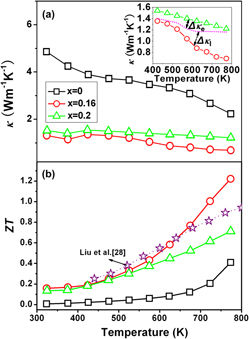Crossref Citations
This article has been cited by the following publications. This list is generated based on data provided by
Crossref.
Mei, Deqing
Wang, Hui
Li, Yang
Yao, Zhehe
and
Zhu, Tiejun
2015.
Microstructure and thermoelectric properties of porous Bi2Te2.85Se0.15 bulk materials fabricated by semisolid powder processing.
Journal of Materials Research,
Vol. 30,
Issue. 17,
p.
2585.
Han, Chao
Sun, Qiao
Li, Zhen
and
Dou, Shi Xue
2016.
Thermoelectric Enhancement of Different Kinds of Metal Chalcogenides.
Advanced Energy Materials,
Vol. 6,
Issue. 15,
Perez‐Taborda, Jaime A.
Vera, Liliana
Caballero‐Calero, Olga
Lopez, Elvis O.
Romero, Juan J.
Stroppa, Daniel G.
Briones, Fernando
and
Martin‐Gonzalez, Marisol
2017.
Pulsed Hybrid Reactive Magnetron Sputtering for High zT Cu2Se Thermoelectric Films.
Advanced Materials Technologies,
Vol. 2,
Issue. 7,
Owens‐Baird, Bryan
Heinrich, Shannon
and
Kovnir, Kirill
2017.
Encyclopedia of Inorganic and Bioinorganic Chemistry.
p.
1.
Gu, B. C.
Li, Z.
Liu, J. D.
Zhang, H. J.
and
Ye, B. J.
2019.
Effect of vacancies on thermoelectric properties of β-CuAgSe studied by positron annihilation.
Applied Physics Letters,
Vol. 115,
Issue. 19,
Lu, Jianhua
Li, Decong
Liu, Wenting
Shen, Lanxian
Chen, Jiali
Ge, Wen
and
Deng, Shukang
2020.
Thermal stability and thermoelectric properties of Cd-doped nano-layered Cu2Se prepared using NaCl flux method*
.
Chinese Physics B,
Vol. 29,
Issue. 12,
p.
127403.
Mikuła, Andrzej
Mars, Krzysztof
Nieroda, Paweł
and
Rutkowski, Paweł
2021.
Copper Chalcogenide–Copper Tetrahedrite Composites—A New Concept for Stable Thermoelectric Materials Based on the Chalcogenide System.
Materials,
Vol. 14,
Issue. 10,
p.
2635.
Wang, Chong-Yu
Yang, Tian-Yu
Zhang, Yi-Xin
Feng, Jing
and
Ge, Zhen-Hua
2025.
Iodine Doping for the Tunable Phase Structure and Enhanced Thermoelectric Performance in Copper Selenide.
Crystal Growth & Design,
Vol. 25,
Issue. 4,
p.
1237.
